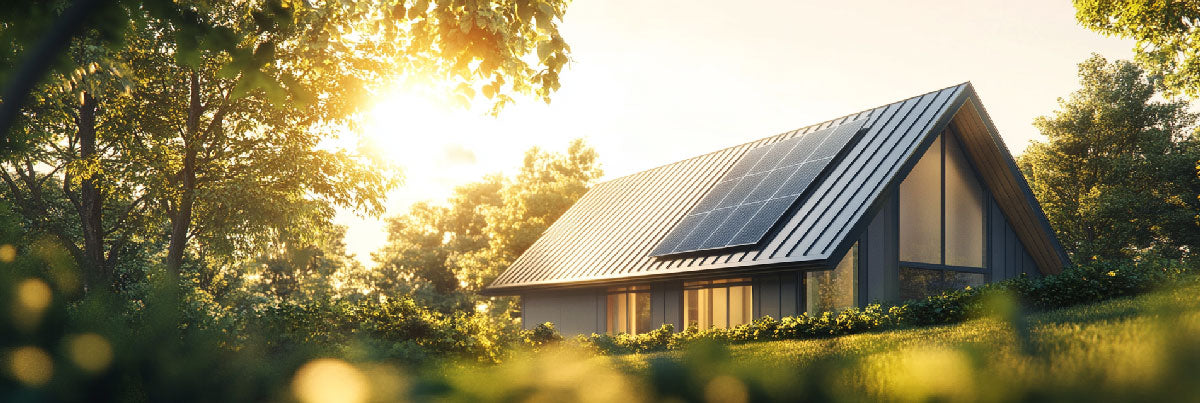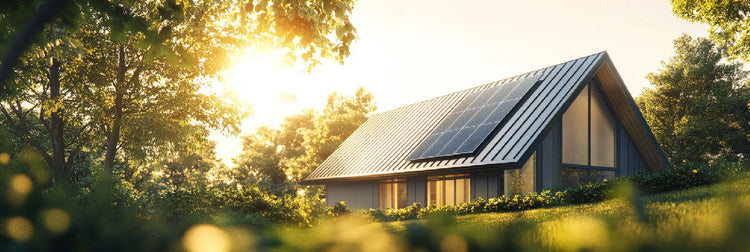Metal Roof Benefits: Sustainability Unveiled
When considering eco-friendly roofing solutions, metal roofs stand out as a top choice. Known for their durability, recyclability, and energy-efficient properties, metal roofs offer significant advantages for homeowners who prioritize sustainability. This blog will explore why metal roofs are an environmentally conscious option, examining their long lifespan, reduced environmental impact, and the energy savings they provide. Discover how investing in a metal roof not only benefits your home but also contributes to a greener future.
Key Takeaways:
- Metal roofs are sustainable, eco-friendly, and fully recyclable.
- Long lifespan and durability reduce environmental impact and resource use.
- Metal roofs contribute to energy efficiency and promote greener living.
Why Are Metal Roofs Sustainable?
Metal roofs are celebrated for their eco-friendly characteristics and long-term environmental benefits. Here’s why metal roofing is a top choice for sustainability-conscious homeowners:
Recyclability
- High Recycled Content: Metal roofs are often manufactured using a significant percentage of recycled materials, reducing the demand for virgin resources and minimizing the environmental impact of extraction and production. For example, steel roofs typically contain at least 25% recycled content, while some metal roofs can have up to 95% recycled content.
- 100% Recyclable: Unlike asphalt shingles that end up in landfills, metal roofs are 100% recyclable at the end of their lifespan. This means the metal can be used to create new products, reducing waste and promoting a circular economy. This eliminates the need for new raw materials, saving energy and reducing greenhouse gas emissions associated with manufacturing.
- Reduced Landfill Waste: By choosing a recyclable metal roof, you contribute to reducing the millions of tons of asphalt shingles that end up in landfills each year.
Longevity
- Long Lifespan: Metal roofs are renowned for their exceptional durability and longevity. They can last 40-70 years, or even longer with proper maintenance, far surpassing traditional roofing materials like asphalt shingles, which typically last only 12-20 years.
- Reduced Replacements: The long lifespan of metal roofs means fewer replacements are needed over time. This translates to less waste going to landfills and a reduced need for raw materials to manufacture new roofs.
- Conserves Resources: Fewer replacements also mean less energy is consumed in the manufacturing and transportation of roofing materials, further contributing to sustainability.
Energy Efficiency:
- Reflects Solar Radiation: Metal roofs have high solar reflectance, meaning they reflect a significant portion of the sun's energy away from the building. This helps to keep your home cooler in the summer, reducing the need for air conditioning and lowering energy consumption.
- Lower Energy Bills: By reducing cooling costs, metal roofs can lead to significant savings on your energy bills over time.
- Reduced Carbon Footprint: Lower energy consumption translates to fewer greenhouse gas emissions, helping to combat climate change.
- Increased Comfort: A cooler home means increased comfort and reduced reliance on energy-intensive cooling systems.
In addition to these key benefits, metal roofs also offer other sustainable features, such as:
- Reduced transportation impact: Metal roofs are often lighter than other roofing materials, which can reduce transportation costs and associated emissions.
- Compatibility with green building practices: Metal roofs can be integrated with other sustainable technologies, such as solar panels and rainwater harvesting systems.
- Urban heat island mitigation: The reflective properties of metal roofs can help to reduce the urban heat island effect in cities.
By choosing a metal roof, you're making a smart investment in a sustainable and eco-friendly roofing solution that will benefit both your home and the environment for decades to come.
Durability and Environmental Impact
Durability is a crucial aspect of sustainability, and metal roofs excel in this area, offering homeowners peace of mind and significant long-term benefits:
Weather Resistance
Metal roofs are engineered to withstand severe weather conditions, including high winds, hail, heavy rainfall, and even snow accumulation. Their resilience reduces the need for frequent repairs or replacements, which in turn minimizes waste and the demand for additional resources. This unmatched ability to endure extreme weather enhances the overall sustainability of a building by extending the roof's lifecycle and preventing material waste.
Low Maintenance
Unlike other roofing materials that require regular maintenance, metal roofs are known for their minimal upkeep needs. This not only saves homeowners time and money but also significantly cuts down on the environmental impact associated with repair materials and chemicals commonly used in maintenance. By requiring fewer resources over their lifespan, metal roofs contribute to a more sustainable and less wasteful roofing solution.
Eco-Friendly Coatings
Modern metal roofs are often treated with specialized, non-toxic coatings that enhance their reflective properties. These coatings help to improve energy efficiency by reflecting more sunlight and reducing heat absorption, which contributes to a cooler indoor environment. Such coatings also extend the life of the roof by protecting against corrosion and wear, further bolstering its durability and sustainability. Importantly, these coatings are designed to be environmentally safe, ensuring that metal roofs do not release harmful substances into the atmosphere or water supply.
By incorporating these durability-focused features, metal roofs support environmental conservation and provide homeowners with a robust, sustainable roofing option that performs reliably for decades.
Recycling and Lifecycle Benefits
Metal roofing supports a circular economy and offers substantial environmental advantages throughout its lifecycle:
Recycled Content
Metal roofs are often constructed using 25-95% recycled materials, significantly reducing the need for new resource extraction and minimizing the environmental impact associated with sourcing raw materials. This reliance on recycled content supports sustainable industry practices and promotes conservation.
End-of-Life Recyclability
One of the most impressive aspects of metal roofing is its full recyclability at the end of its life. Unlike many traditional roofing materials that contribute to growing landfill waste, metal roofs can be recycled and repurposed into new products. This process not only cuts down on environmental waste but also supports the reduction of carbon emissions by limiting the demand for virgin materials and energy-intensive manufacturing. The continuous cycle of reuse aligns with the principles of a circular economy, reinforcing the role of metal roofing in promoting sustainable living.
This holistic approach to sustainability—from sourcing and manufacturing to end-of-life recycling—underscores why metal roofs are considered one of the most eco-friendly roofing choices available today.
How Metal Roofs Compare to Other Materials
When assessing the eco-friendliness of various roofing options, metal roofs outshine traditional materials due to their unique sustainability and durability benefits. Here’s a closer look:
Asphalt Shingles
Asphalt shingles are the most common roofing material, known for their low upfront cost. However, they come with significant environmental drawbacks. Their typical lifespan of 12-20 years means frequent replacements are necessary, contributing heavily to landfill waste. Additionally, asphalt shingles are petroleum-based, adding to the extraction and consumption of non-renewable resources and increasing carbon emissions during manufacturing.

Wood Shakes
While wood shakes can be a natural and aesthetically pleasing option, they require chemical treatments to resist fire, moisture, and insects. These treatments can introduce harmful substances into the environment over time. Moreover, sourcing wood for shakes may contribute to deforestation unless it is certified as sustainably harvested.

Clay and Concrete Tiles
These materials are known for their durability and fire resistance. However, their production process is highly energy-intensive, involving significant emissions from kilns and manufacturing facilities. The heavy nature of clay and concrete tiles also means more resources are needed for transportation and installation, which increases their overall carbon footprint. Additionally, while clay and concrete can last longer than asphalt, they are prone to cracking under extreme conditions and may require replacement over time.

Energy Efficiency and Cost Savings
Metal roofs help reduce energy costs through their reflective properties:
Reflectivity
Metal roofs have a natural ability to reflect solar radiation, which keeps buildings cooler during the summer months. This reflectivity significantly decreases the amount of heat absorbed by the roof, leading to reduced indoor temperatures and a diminished reliance on air conditioning. By lowering cooling demands, homeowners can experience significant energy cost savings, especially in hotter climates.
Insulation Compatibility
Metal roofing works exceptionally well when paired with additional insulation materials and radiant barriers. These combinations enhance the energy efficiency of the building, ensuring minimal heat transfer and greater temperature regulation. Insulation prevents warm air from escaping during the colder months and keeps heat out during warmer periods, creating an optimized, energy-efficient home environment.
Year-Round Benefits
One of the standout advantages of metal roofing is its versatility in various climates. While highly effective in reflecting solar heat during the summer, metal roofs also contribute to energy efficiency in colder weather. When coupled with proper insulation, metal roofs help retain heat within the building, reducing the need for excessive heating. This year-round energy performance translates to consistent cost savings for homeowners, making metal roofs a wise long-term investment.
Additional Sustainable Roofing Options
While metal roofs offer impressive sustainability benefits, homeowners seeking eco-friendly alternatives may explore several other roofing options that contribute to a greener environment:
Solar Roofing
This innovative solution incorporates solar panels directly into the roof structure, transforming rooftops into renewable energy generators. Solar roofing not only provides electricity for the home but also lowers dependence on grid power, reducing carbon emissions and energy bills. With advances in technology, solar roofing options now blend seamlessly with traditional roof designs, making them both efficient and visually appealing.
Green Roofs
Also known as living roofs, green roofs are covered with vegetation and soil. This type of roofing brings nature into urban areas, creating habitats for birds and beneficial insects. Green roofs help improve air quality, manage stormwater by absorbing rain, and provide natural insulation, reducing both heating and cooling costs. They also contribute to mitigating the urban heat island effect, making cities more livable and environmentally balanced.
Recycled Shingle Roofs
Recycled shingles are crafted from reclaimed materials such as rubber, plastic, and wood fibers, which would otherwise end up in landfills. These shingles provide a durable and eco-friendly alternative to traditional asphalt. By using recycled resources, homeowners help conserve raw materials and reduce environmental impact. Recycled shingle roofs often come in various colors and styles, offering an attractive yet sustainable roofing solution that maintains the aesthetic value of a home.
Conclusion
Metal roofs stand as a sustainable, long-lasting, and energy-efficient choice for environmentally conscious homeowners. With their durability, recyclable nature, and cost-saving energy benefits, metal roofs contribute to a greener, more sustainable future.

